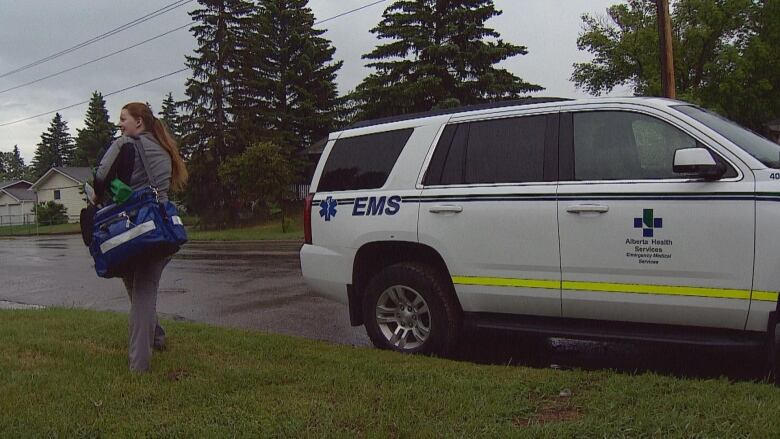Paramedic house calls spike as Calgary-based program grows
Frail, immobile patients treated in their home, avoiding costly trips to the ER

Tracy McNair no longer wakes up worrying she may have a stroke. She no longer drags her family to the emergency department whenever her blood pressure spikes through the roof.
Instead, a community paramedic treats McNair's hypertension with medication in her home three times a week, giving her a better quality of life.
"It's amazing, it's like I just know I have relief, so it makes me smile," said McNair, who was diagnosed with refractory hypertension in 2013.
"I actually don't think I'd be here today talking to you if I hadn't got the treatment," added the 52-year-old, who suffers from severe headaches and has had several mini strokes.
McNair isamong the hundreds of patients whom community paramedics will attend to this year in the Calgary area.
The program started in 2012. Within the first year, paramedics made 1,548 visits to peoplewhere they live, whether that's a house, a shelter, a long-term care facility or the street, in the case of the city's homeless population.
In 2018, community paramedics made 8,658 visits.
Alberta Health Services says there are many benefits to this service, one being the cost savings.
It says it is $1,100 less expensive for a community paramedic to see a patient in the community than to have the same treatment provided in hospital, based upon data from Calgary in 2012.
Community paramedics drive around in an SUV, instead of an ambulanceand oftentreat people with chronic conditions who are frail, elderly, have poor mobility, a lack of social supportor difficulties accessing care through traditional methods.
They can provide sutures, insert catheters, give medicine and offer other interventions that best suit the patient.
Patients are referred by a health-care professional. Paramedics work with a patient's doctor or nurse practitioner to develop a treatment plan and monitor a patient's progress.
From palliative to preventative
Before being referred to this program three years ago, McNair was receiving palliative care for her extremely high blood pressurebecause her doctor felt there wasn't anything they could do for her other than sit and wait for the inevitable.
At one point, McNair's blood pressure averaged250/150 double that of a healthy person's, which is 120/80. That put her at extreme risk of stroke.
Now, she says, her blood pressure averages 230/130, considereda slight improvement.
"Just that preventative, that I'm having constant medical care so oftenhas literally saved my life, and I'm so appreciative, so grateful."
It means she can spend more quality time with her family orenjoy a lunch out with friends.
That I'm having constant medical care so oftenhas literally saved my life, and I'm so appreciative, so grateful.- Tracy McNair, community paramedicpatient
"I have a young son, so I can be more involved in his life, whereas I was feeling thatI couldn't really do anything."

Holistic care model
McNair says she always dreaded having to go tothe emergency department to treat her high blood pressure because each time she went she would have to explain her situation to a new nurse or doctor. Plus she says she felt guilty bringing her family along,knowing they'd be stuck sitting with her for hours before she was treated.
This way, McNair, and other patients, canbuild a longer-termrelationship with the community paramedics, which is beneficial to patients
"It's night and day, and they make you feel very safe, very comfortable, and very, very knowledgeable, but the compassion and the relationship, that's very high," said McNair.
Relationship-building isalsokey forthe paramedics.
"A lot of patients we do get to see again,so we get to see their progress, their satisfaction," said Lisa McQuade, who started working as a community paramedic in 2014.
McQuade says paramedics already have most of the skills required to do this job. Some additional training is all that is required.
The program has expanded toinclude 50 positions in the Calgary area.
"We're growing, and with that paramedics are getting to expand what we are doing, and that's all the satisfaction you need really," said McQuade.
The program has also expanded across Alberta, thanks to provincial funding.
In 2017, the provincial government allocated more than $10 million to expand community paramedicine to other areas so patients could access the benefits of the programs already operating in Edmonton and Calgary.
It's now operating as far north as Peace River and south to Lethbridge and Medicine Hat.












_(720p).jpg)


 OFFICIAL HD MUSIC VIDEO.jpg)
.jpg)



























































































